NASA的“每日天文一图”(2008年)(updated to now)
来源:百度文库 编辑:超级军网 时间:2024/04/27 19:37:43
]]
2008 January 1
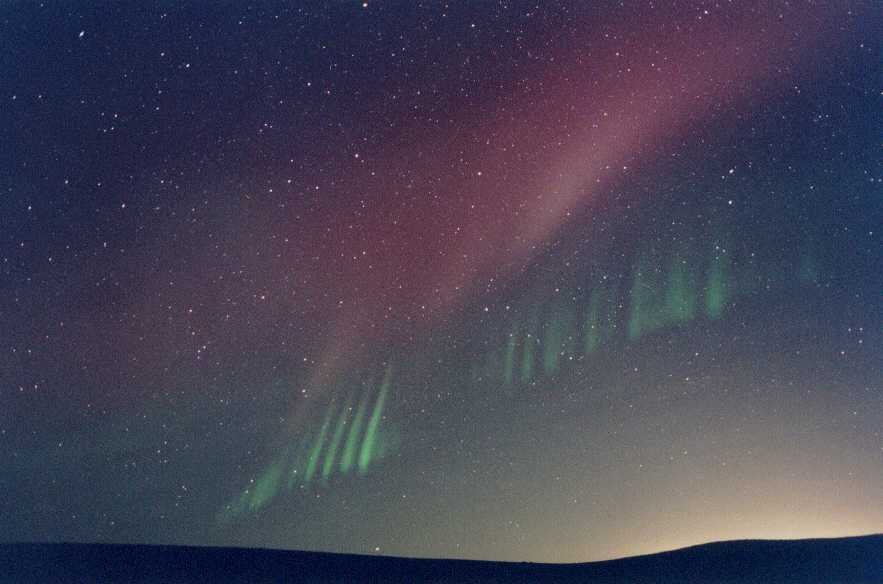
Rays from an Unexpected Aurora
Credit & Copyright: Lyndon Anderson (Prairie Journal)
Explanation: This aurora was a bit of a surprise. For starters, on this day in 2002, no intense auroral activity was expected at all. Possibly more surprising, however, the aurora appeared to show an usual structure of green rays from some locations. In this view, captured from North Dakota, USA, a picket fence of green rays stretches toward the horizon. Mirroring the green rays is a red band, somewhat rare in its own right. Lights from the cities of Bismarck and Mandan are visible near the horizon.

Rays from an Unexpected Aurora
Credit & Copyright: Lyndon Anderson (Prairie Journal)
Explanation: This aurora was a bit of a surprise. For starters, on this day in 2002, no intense auroral activity was expected at all. Possibly more surprising, however, the aurora appeared to show an usual structure of green rays from some locations. In this view, captured from North Dakota, USA, a picket fence of green rays stretches toward the horizon. Mirroring the green rays is a red band, somewhat rare in its own right. Lights from the cities of Bismarck and Mandan are visible near the horizon.
2008 年 01 月 02 日

星系不是彗星
影像提供及版权:Emiel Kempen
说明:在12月30日拍摄于荷兰霍赫芬上空的这张影像中,有一个绚丽的星系和一个彗星状的天体。经过合成60张,每张曝光60秒的影像后,发现具有可爱绿色彗发的8P/Tuttle彗星与北三角星座接近于合。连接每一张曝光影像就能显示出彗星形成一条轨迹,慢慢地朝远离星系的方向运行。另一张合成影像中央显示的是彗星,而背景中的恒星和星系则形成了轨迹。这幅迷人的天空景象同时也将纪念18世纪具有影响力的彗星追逐者查尔斯.梅西耶。当梅西耶在搜寻法国天空中的彗星时,他非常仔细地记录了天体的位置,发现外表模糊类似彗星的天体相对于背景恒星来说并没有移动,所以并没有把它归类为彗星。北三角星系也被称为M33 ,是著名非彗星天体表中第33个天体。按现在的理解认识北三角星系,它是一个距离我们300万光年远的巨大旋涡星系。在北半球黑暗夜空中,8P/Tuttle彗星肉眼可见,距离我们大约4,000万公里(2光分)远。

星系不是彗星
影像提供及版权:Emiel Kempen
说明:在12月30日拍摄于荷兰霍赫芬上空的这张影像中,有一个绚丽的星系和一个彗星状的天体。经过合成60张,每张曝光60秒的影像后,发现具有可爱绿色彗发的8P/Tuttle彗星与北三角星座接近于合。连接每一张曝光影像就能显示出彗星形成一条轨迹,慢慢地朝远离星系的方向运行。另一张合成影像中央显示的是彗星,而背景中的恒星和星系则形成了轨迹。这幅迷人的天空景象同时也将纪念18世纪具有影响力的彗星追逐者查尔斯.梅西耶。当梅西耶在搜寻法国天空中的彗星时,他非常仔细地记录了天体的位置,发现外表模糊类似彗星的天体相对于背景恒星来说并没有移动,所以并没有把它归类为彗星。北三角星系也被称为M33 ,是著名非彗星天体表中第33个天体。按现在的理解认识北三角星系,它是一个距离我们300万光年远的巨大旋涡星系。在北半球黑暗夜空中,8P/Tuttle彗星肉眼可见,距离我们大约4,000万公里(2光分)远。
2008 年 01 月 03 日

2007双子座流星雨
影像提供及版权:Erno Berko
说明:来自近地小行星3200 Phaethon的尘埃从双子座方向落到地球上,从而形成了这张流星雨壮观影像。这张合成影像是12月份在匈牙利Ludanyhalaszi经过4个夜晚(12-15)拍摄后合成。当然,这些轨迹是每年发生的双子座流星雨流星划过天空的轨迹。天文学家Erno Berko完成了影像合成的工作,他将113 张不同影像合成,拍摄到了123颗流星。双子座流星雨是北半球最可靠的流星雨之一,去年并没有让人失望。在良好的观测条件下,一些天空观测者报告说在2007年12月14/15日双子座流星雨高峰时,每小时超过100颗流星。今晚抬头仰望天空,你可能会看到2008年的象限仪座流星雨。

2007双子座流星雨
影像提供及版权:Erno Berko
说明:来自近地小行星3200 Phaethon的尘埃从双子座方向落到地球上,从而形成了这张流星雨壮观影像。这张合成影像是12月份在匈牙利Ludanyhalaszi经过4个夜晚(12-15)拍摄后合成。当然,这些轨迹是每年发生的双子座流星雨流星划过天空的轨迹。天文学家Erno Berko完成了影像合成的工作,他将113 张不同影像合成,拍摄到了123颗流星。双子座流星雨是北半球最可靠的流星雨之一,去年并没有让人失望。在良好的观测条件下,一些天空观测者报告说在2007年12月14/15日双子座流星雨高峰时,每小时超过100颗流星。今晚抬头仰望天空,你可能会看到2008年的象限仪座流星雨。
2008 年 01 月 04 日

5公里上空看到的银河
影像提供及版权:Serge Brunier
说明:距离海平面5,000米(16,500英尺),在智利安第斯山脉北部Cerro Chajnantor附近,你所看到的夜空就会像这幅宇宙场景一样。这张壮观的鱼眼影像拍摄于干燥的高处,显示了我们银河系内无数颗恒星以及广袤的尘埃云。星系中央的方向就是天顶附近,就位于影像的中央,但星系的中心就隐藏在影像模糊尘埃后方的深处。明亮的木星突出在这张影像中,它就位于银河系中央隆起部分的上方,那里异常的昏暗,略带黄色的巨恒星心宿二就位于木星的右侧。在这张影像的右边缘附近,有一个细小而昏暗的星系,那就是银河系许多卫星星系之一—小麦哲伦星系。

5公里上空看到的银河
影像提供及版权:Serge Brunier
说明:距离海平面5,000米(16,500英尺),在智利安第斯山脉北部Cerro Chajnantor附近,你所看到的夜空就会像这幅宇宙场景一样。这张壮观的鱼眼影像拍摄于干燥的高处,显示了我们银河系内无数颗恒星以及广袤的尘埃云。星系中央的方向就是天顶附近,就位于影像的中央,但星系的中心就隐藏在影像模糊尘埃后方的深处。明亮的木星突出在这张影像中,它就位于银河系中央隆起部分的上方,那里异常的昏暗,略带黄色的巨恒星心宿二就位于木星的右侧。在这张影像的右边缘附近,有一个细小而昏暗的星系,那就是银河系许多卫星星系之一—小麦哲伦星系。
2008 January 5
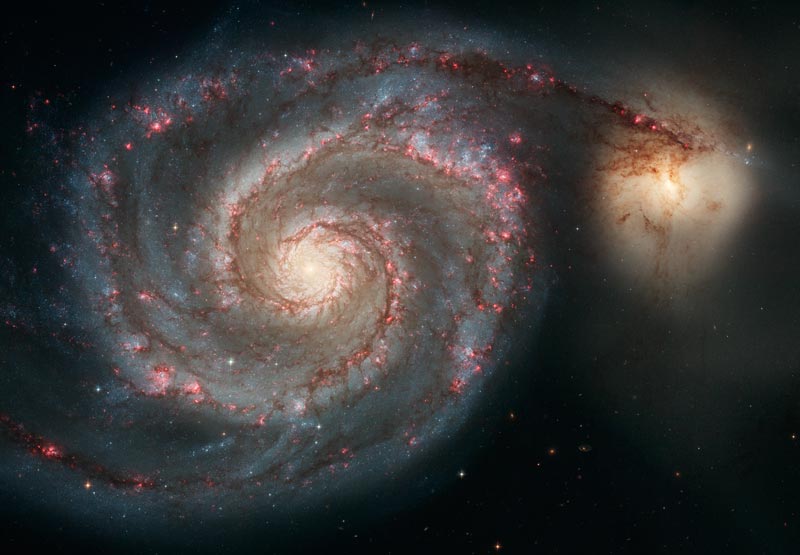
M51: Cosmic Whirlpool
Credit: S. Beckwith (STScI) Hubble Heritage Team, (STScI/AURA), ESA, NASA
Explanation: Follow the handle of the Big Dipper away from the dipper's bowl, until you get to the handle's last bright star. Then, just slide your telescope a little south and west and you might find this stunning pair of interacting galaxies, the 51st entry in Charles Messier's famous catalog. Perhaps the original spiral nebula, the large galaxy with well defined spiral structure is also cataloged as NGC 5194. Its spiral arms and dust lanes clearly sweep in front of its companion galaxy (right), NGC 5195. The pair are about 31 million light-years distant and officially lie within the boundaries of the small constellation Canes Venatici. Though M51 looks faint and fuzzy in small, earthbound telescopes, this sharpest ever picture of M51 was made in January 2005 with the Advanced Camera for Surveys on board the Hubble Space Telescope.

M51: Cosmic Whirlpool
Credit: S. Beckwith (STScI) Hubble Heritage Team, (STScI/AURA), ESA, NASA
Explanation: Follow the handle of the Big Dipper away from the dipper's bowl, until you get to the handle's last bright star. Then, just slide your telescope a little south and west and you might find this stunning pair of interacting galaxies, the 51st entry in Charles Messier's famous catalog. Perhaps the original spiral nebula, the large galaxy with well defined spiral structure is also cataloged as NGC 5194. Its spiral arms and dust lanes clearly sweep in front of its companion galaxy (right), NGC 5195. The pair are about 31 million light-years distant and officially lie within the boundaries of the small constellation Canes Venatici. Though M51 looks faint and fuzzy in small, earthbound telescopes, this sharpest ever picture of M51 was made in January 2005 with the Advanced Camera for Surveys on board the Hubble Space Telescope.
2008 January 6
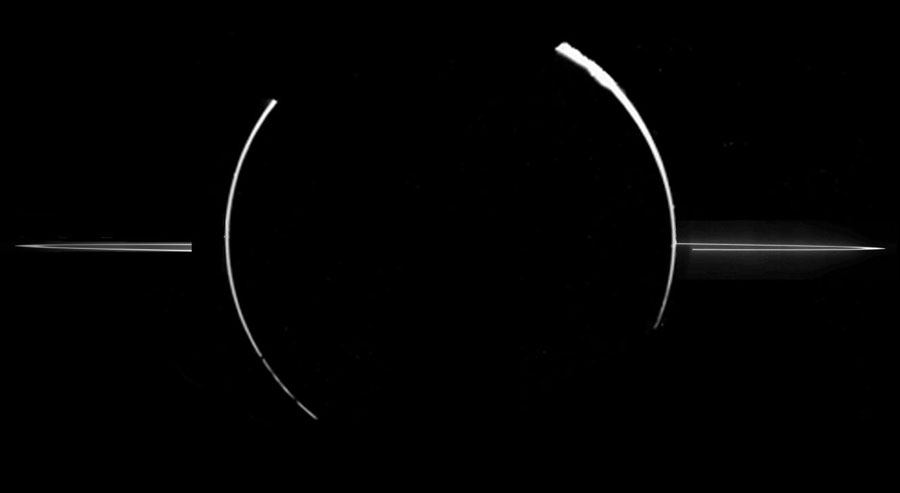
Jupiter's Rings Revealed
Credit: (NOAO), J. Burns (Cornell) et al., Galileo Project, JPL, NASA
Explanation: Why does Jupiter have rings? Jupiter's rings were discovered in 1979 by the passing Voyager 1 spacecraft, but their origin was a mystery. Data from the Galileo spacecraft that orbited Jupiter from 1995 to 2003 later confirmed that these rings were created by meteoroid impacts on small nearby moons. As a small meteoroid strikes tiny Adrastea, for example, it will bore into the moon, vaporize, and explode dirt and dust off into a Jovian orbit. Pictured above is an eclipse of the Sun by Jupiter, as viewed from Galileo. Small dust particles high in Jupiter's atmosphere, as well as the dust particles that compose the rings, can be seen by reflected sunlight.

Jupiter's Rings Revealed
Credit: (NOAO), J. Burns (Cornell) et al., Galileo Project, JPL, NASA
Explanation: Why does Jupiter have rings? Jupiter's rings were discovered in 1979 by the passing Voyager 1 spacecraft, but their origin was a mystery. Data from the Galileo spacecraft that orbited Jupiter from 1995 to 2003 later confirmed that these rings were created by meteoroid impacts on small nearby moons. As a small meteoroid strikes tiny Adrastea, for example, it will bore into the moon, vaporize, and explode dirt and dust off into a Jovian orbit. Pictured above is an eclipse of the Sun by Jupiter, as viewed from Galileo. Small dust particles high in Jupiter's atmosphere, as well as the dust particles that compose the rings, can be seen by reflected sunlight.
2008 年 01 月 07 日

象限仪座流星雨和天空中的极光
影像提供:Jeremie Vaubaillon et al., Caltech, NASA
说明:流星雨源自哪里?为了回答这个问题,天文学家们对上周末发生的象限仪座流星雨进行了仔细的观测。较特别的是,天文学家将相机放在象限仪座流星雨多重仪器飞行联测上,在过去几天里搭乘NASA DC-8飞机飞越加拿大北部上空飞行的,象限仪座流星雨进行了空前详细的研究。上面是一张合成的影像,合成了许多单张曝光影像而成。在影像中可以看到飞机左侧反射的红光,影像右侧最为显著的是绿色的极光,以及无数颗贯穿整张影像的流星轨迹。初步结果显示流星雨极大值的时间非常稳定,但在数量上变化很大。从MAC飞机上观察流星雨高峰期间,每小时可达100多颗流星。来自全球的流星数据将继续被用来分析,以证实Peter Jenniskens最近的假设,小行星2003EH1是一颗间歇性活跃的彗星,是发生每年象限仪座流星雨的母体。

象限仪座流星雨和天空中的极光
影像提供:Jeremie Vaubaillon et al., Caltech, NASA
说明:流星雨源自哪里?为了回答这个问题,天文学家们对上周末发生的象限仪座流星雨进行了仔细的观测。较特别的是,天文学家将相机放在象限仪座流星雨多重仪器飞行联测上,在过去几天里搭乘NASA DC-8飞机飞越加拿大北部上空飞行的,象限仪座流星雨进行了空前详细的研究。上面是一张合成的影像,合成了许多单张曝光影像而成。在影像中可以看到飞机左侧反射的红光,影像右侧最为显著的是绿色的极光,以及无数颗贯穿整张影像的流星轨迹。初步结果显示流星雨极大值的时间非常稳定,但在数量上变化很大。从MAC飞机上观察流星雨高峰期间,每小时可达100多颗流星。来自全球的流星数据将继续被用来分析,以证实Peter Jenniskens最近的假设,小行星2003EH1是一颗间歇性活跃的彗星,是发生每年象限仪座流星雨的母体。
2008 年 01 月 08 日

新视野号拍摄到的木星与木卫一影像
影像提供:NASA, Johns Hopkins U. APL, SWRI
说明:当新视野号飞船飞越太阳系时,在飞越行星的同时并为它们拍摄了惊人的影像。去年二月,新视野号飞船通过木星以及曾经很活跃的木卫一。在这张影像中,拍摄于红外光线三色波带下的木星,原本外表巨大的红点看起来有点泛白。在木星复杂的大气层中可以看到类似飓风一样复杂的椭圆形旋涡,以及行星环带。木卫一是用自然色彩经过数字叠加后形成。偶然的是,影像还拍摄到了从木卫一Tvashtar火山喷发出的一道羽状烟柱。冰霜和熔岩覆盖在这颗多火山的卫星上,同时在发出蓝色散射光芒的羽状烟柱下还可以看到发出红光的熔岩。预计新视野号飞船将在2015年到达冥王星。

新视野号拍摄到的木星与木卫一影像
影像提供:NASA, Johns Hopkins U. APL, SWRI
说明:当新视野号飞船飞越太阳系时,在飞越行星的同时并为它们拍摄了惊人的影像。去年二月,新视野号飞船通过木星以及曾经很活跃的木卫一。在这张影像中,拍摄于红外光线三色波带下的木星,原本外表巨大的红点看起来有点泛白。在木星复杂的大气层中可以看到类似飓风一样复杂的椭圆形旋涡,以及行星环带。木卫一是用自然色彩经过数字叠加后形成。偶然的是,影像还拍摄到了从木卫一Tvashtar火山喷发出的一道羽状烟柱。冰霜和熔岩覆盖在这颗多火山的卫星上,同时在发出蓝色散射光芒的羽状烟柱下还可以看到发出红光的熔岩。预计新视野号飞船将在2015年到达冥王星。
2008 年 01 月 09 日

从基特峰拍摄到被遮蔽的IC342星系
影像提供及版权:T. Rector (U. Alaska Anchorage), H. Schweiker, WIYN, NOAO, AURA, NSF
说明:如果附近美丽的旋涡星云IC342没有被遮蔽的话,将会更加有名。作为一个弥漫的宇宙岛,IC342将是我们地球夜空中一个显著的星系,但它几乎被我们银河系盘面内的恒星,气体尘埃云掩盖了。与其它巨大明亮的旋涡星系大小类似,IC342距离我们大约700万光年,位于北天星座鹿豹座的长颈上。尽管IC342发出的光经过宇宙星云干涉后显得很暗淡,但这一清晰的望远镜影像还是拍摄到了星系本身模糊的尘埃,蓝色恒星团,以及在星核围散开的旋臂上发出炽热粉红光芒的恒星形成区域。在IC342星系里,恒星形成活跃区域中最近很可能发生过了一次爆炸,距离很近,引力作用足够能影响到本星系群和银河系的演变了。

从基特峰拍摄到被遮蔽的IC342星系
影像提供及版权:T. Rector (U. Alaska Anchorage), H. Schweiker, WIYN, NOAO, AURA, NSF
说明:如果附近美丽的旋涡星云IC342没有被遮蔽的话,将会更加有名。作为一个弥漫的宇宙岛,IC342将是我们地球夜空中一个显著的星系,但它几乎被我们银河系盘面内的恒星,气体尘埃云掩盖了。与其它巨大明亮的旋涡星系大小类似,IC342距离我们大约700万光年,位于北天星座鹿豹座的长颈上。尽管IC342发出的光经过宇宙星云干涉后显得很暗淡,但这一清晰的望远镜影像还是拍摄到了星系本身模糊的尘埃,蓝色恒星团,以及在星核围散开的旋臂上发出炽热粉红光芒的恒星形成区域。在IC342星系里,恒星形成活跃区域中最近很可能发生过了一次爆炸,距离很近,引力作用足够能影响到本星系群和银河系的演变了。
2008 年 01 月 10 日

活动星系半人马座A
影像提供:X射线 - NASA, CXC, R.Kraft (CfA), et al.;
射电- NSF, VLA, M.Hardcastle (U Hertfordshire) et al.; 可见光 - ESO, M.Rejkuba (ESO-Garching) et al.
说明:巨大的椭圆星系半人马座A距离我们近1,100光年远,也是距离地球最近的活动星系。这张壮观的合成影像中,合成星系影像的数据分别来自X射线(钱德拉),可见光(ESO),和射电(VLA)下拍摄得到。在可见光下,半人马座A的中心区域由气体、尘埃以及恒星混合而成,但在射电和X射线望远镜下都能看到从星系核内喷射出一道壮观的高能微粒喷流。宇宙微粒加速器的能量源是一个黑洞,质量大约是太阳的1,000万倍,就是X射线下星系核中央的蓝点。高能喷流从活动星系核喷向影像左上方,一直延长大约有1.3万光年远。而从星系核爆发的另一个较小的喷流朝向反方向。在这片区域中,其它X射线下的亮点是拥有中子星和黑洞的双星系统。活动星系半人马座A可能是1亿年前与一个旋涡星系合并而成。

活动星系半人马座A
影像提供:X射线 - NASA, CXC, R.Kraft (CfA), et al.;
射电- NSF, VLA, M.Hardcastle (U Hertfordshire) et al.; 可见光 - ESO, M.Rejkuba (ESO-Garching) et al.
说明:巨大的椭圆星系半人马座A距离我们近1,100光年远,也是距离地球最近的活动星系。这张壮观的合成影像中,合成星系影像的数据分别来自X射线(钱德拉),可见光(ESO),和射电(VLA)下拍摄得到。在可见光下,半人马座A的中心区域由气体、尘埃以及恒星混合而成,但在射电和X射线望远镜下都能看到从星系核内喷射出一道壮观的高能微粒喷流。宇宙微粒加速器的能量源是一个黑洞,质量大约是太阳的1,000万倍,就是X射线下星系核中央的蓝点。高能喷流从活动星系核喷向影像左上方,一直延长大约有1.3万光年远。而从星系核爆发的另一个较小的喷流朝向反方向。在这片区域中,其它X射线下的亮点是拥有中子星和黑洞的双星系统。活动星系半人马座A可能是1亿年前与一个旋涡星系合并而成。
2008 年 01 月 11 日

北极星尘埃星云
影像提供及版权:Steve Mandel (Hidden Valley Observatory)
合作研究:Adolf Witt (University of Toledo) et al.
说明:在这张宽4度的广域影像中,中心是北极星,还包含了部分相对生疏且较模糊的复杂尘埃云,高高地漂浮在我们银河系盘面上。银河系恒星发出的光经过尘埃,星系卷云反射后混合在一起,反射星光有一种同样的特征色彩,它们被称为反射星云。但是在这张颜色深暗的影像中,还拍摄到从尘埃发出的昏暗而又略带红色的发光带,它们将不可见的恒星紫外线转变成了可见的红光。那暗淡的宇宙光热被称为广延红色辐射,其被认为是复杂有机分子多环芳烃PAHs,它也是普通的星际尘埃组成成分。在地球上,燃烧之后经常能出现焦黑色的产物那就是多环芳烃。

北极星尘埃星云
影像提供及版权:Steve Mandel (Hidden Valley Observatory)
合作研究:Adolf Witt (University of Toledo) et al.
说明:在这张宽4度的广域影像中,中心是北极星,还包含了部分相对生疏且较模糊的复杂尘埃云,高高地漂浮在我们银河系盘面上。银河系恒星发出的光经过尘埃,星系卷云反射后混合在一起,反射星光有一种同样的特征色彩,它们被称为反射星云。但是在这张颜色深暗的影像中,还拍摄到从尘埃发出的昏暗而又略带红色的发光带,它们将不可见的恒星紫外线转变成了可见的红光。那暗淡的宇宙光热被称为广延红色辐射,其被认为是复杂有机分子多环芳烃PAHs,它也是普通的星际尘埃组成成分。在地球上,燃烧之后经常能出现焦黑色的产物那就是多环芳烃。
2008 January 12

Mercury Chases the Sunset
Image Credit & Copyright: Doug Zubenel
Explanation: This colorful view of the western sky at sunset features last Wednesday's slender crescent Moon. Of course, when the Moon is in its crescent phase it can never be far from the Sun in the sky. Also always close to the Sun in Earth's sky is innermost planet Mercury, seen here below and right of center against the bright orange glow along the horizon. Mercury is usually difficult to glimpse because of overwhelming sunlight, but increasingly better views of the small planet after sunset will be possible as it wanders farther east of the Sun in the coming days. On January 14th, NASA's MESSENGER spacecraft will have a good view too, as it makes its first Mercury flyby.

Mercury Chases the Sunset
Image Credit & Copyright: Doug Zubenel
Explanation: This colorful view of the western sky at sunset features last Wednesday's slender crescent Moon. Of course, when the Moon is in its crescent phase it can never be far from the Sun in the sky. Also always close to the Sun in Earth's sky is innermost planet Mercury, seen here below and right of center against the bright orange glow along the horizon. Mercury is usually difficult to glimpse because of overwhelming sunlight, but increasingly better views of the small planet after sunset will be possible as it wanders farther east of the Sun in the coming days. On January 14th, NASA's MESSENGER spacecraft will have a good view too, as it makes its first Mercury flyby.
2008 January 13
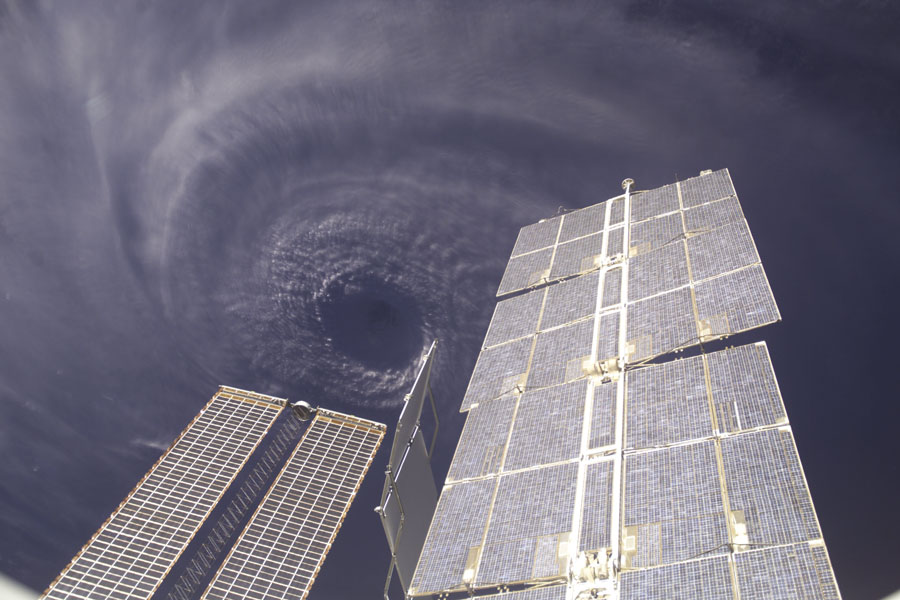
Hurricane Ivan from the Space Station
Credit: Expedition 9 Crew, International Space Station, NASA
Explanation: Ninety percent of the houses on Grenada were damaged by the destructive force of Hurricane Ivan. At its peak, Ivan was a Category 5 hurricane, the highest power category on the Saffir-Simpson Scale, and created sustained winds in excess of 200 kilometers per hour. Ivan was the largest hurricane to strike the US in 2004, and, so far, the 10th most powerful in recorded history. As it swirled in the Atlantic Ocean, the tremendous eye of Hurricane Ivan was photographed from above by the orbiting International Space Station. The name Ivan has now been retired from Atlantic Ocean use by the World Meteorological Organization.

Hurricane Ivan from the Space Station
Credit: Expedition 9 Crew, International Space Station, NASA
Explanation: Ninety percent of the houses on Grenada were damaged by the destructive force of Hurricane Ivan. At its peak, Ivan was a Category 5 hurricane, the highest power category on the Saffir-Simpson Scale, and created sustained winds in excess of 200 kilometers per hour. Ivan was the largest hurricane to strike the US in 2004, and, so far, the 10th most powerful in recorded history. As it swirled in the Atlantic Ocean, the tremendous eye of Hurricane Ivan was photographed from above by the orbiting International Space Station. The name Ivan has now been retired from Atlantic Ocean use by the World Meteorological Organization.
2008 年 01 月 14 日

CFHT望远镜下的茧状星云
影像提供及版权:Jean-Charles Cuillandre (CFHT), Hawaiian Starlight, CFHT
说明:茧状星云的颜色是由什么形成的?茧状星云被编录为IC5146,是距离我们大约4,000光年远,位于天鹅座内的一个美丽而壮观的星云。茧状星云内部有一个正新形成的疏散星团。就像其它恒星孕育场一样,茧状星云同时具有明亮的红色发射星云,蓝色的反射星云以及黑暗的吸收星云的角色。星云不同的形成过程能释放出不同的混合物质,这就形成了这张影像中众多的颜色,影像是由位于美国夏威夷上的加拿大-法国-夏威夷望远镜(CFHT)近期拍摄。基于最近探测得到的数据推测,影像左侧大质量恒星在分子云中打开了一个洞,而炽热物质从中流出。诞生于10万年前的那颗恒星现今正为星云内发出的放射光和反射光提供能源。

CFHT望远镜下的茧状星云
影像提供及版权:Jean-Charles Cuillandre (CFHT), Hawaiian Starlight, CFHT
说明:茧状星云的颜色是由什么形成的?茧状星云被编录为IC5146,是距离我们大约4,000光年远,位于天鹅座内的一个美丽而壮观的星云。茧状星云内部有一个正新形成的疏散星团。就像其它恒星孕育场一样,茧状星云同时具有明亮的红色发射星云,蓝色的反射星云以及黑暗的吸收星云的角色。星云不同的形成过程能释放出不同的混合物质,这就形成了这张影像中众多的颜色,影像是由位于美国夏威夷上的加拿大-法国-夏威夷望远镜(CFHT)近期拍摄。基于最近探测得到的数据推测,影像左侧大质量恒星在分子云中打开了一个洞,而炽热物质从中流出。诞生于10万年前的那颗恒星现今正为星云内发出的放射光和反射光提供能源。
2008 年 01 月 15 日

双超新星遗迹DEM L316
影像提供及版权:Gemini Observatory, GMOS-South, NSF
说明:这两个超新星遗迹相互间有关系吗?为了找出答案,位于智利山顶上的8米双子望远镜指向了这个奇特,巨大而又具有双瓣的DEM L316。上面显示的影像,收获了大量重要的信息。仔细检查这张影像,同时查看钱德拉X射线天文台拍摄的数据来看两个超新星遗迹有什么不同。特别是,较小的遗迹好像是Ⅰ类超新星爆发的结果(白矮星爆炸),而较大的那个遗迹好像是Ⅱ类超新星爆发的结果(一颗普通大质量恒星爆炸)。因为两颗恒星类型在不同时间段演变,所以它们应该不是同时形成,在物理空间上是没有联系。而且没有证据表明两个遗迹发生碰撞,它们只是碰巧在我们的视线方向上重叠。DEM L316位于距离我们大约16万光年远的大麦哲伦星系内,大小约140光年,位于南方星座剑鱼座内。

双超新星遗迹DEM L316
影像提供及版权:Gemini Observatory, GMOS-South, NSF
说明:这两个超新星遗迹相互间有关系吗?为了找出答案,位于智利山顶上的8米双子望远镜指向了这个奇特,巨大而又具有双瓣的DEM L316。上面显示的影像,收获了大量重要的信息。仔细检查这张影像,同时查看钱德拉X射线天文台拍摄的数据来看两个超新星遗迹有什么不同。特别是,较小的遗迹好像是Ⅰ类超新星爆发的结果(白矮星爆炸),而较大的那个遗迹好像是Ⅱ类超新星爆发的结果(一颗普通大质量恒星爆炸)。因为两颗恒星类型在不同时间段演变,所以它们应该不是同时形成,在物理空间上是没有联系。而且没有证据表明两个遗迹发生碰撞,它们只是碰巧在我们的视线方向上重叠。DEM L316位于距离我们大约16万光年远的大麦哲伦星系内,大小约140光年,位于南方星座剑鱼座内。
2008 年 01 月 16 日

MESSENGER飞船靠近水星
影像提供:MESSENGER Teams, JHU APL, NASA
说明:两天前,MESSENGER飞船成为人类历史上第二颗掠过水星的探测器。上一艘拜访距离太阳最近行星的飞船是Mariner 10,那已经是35年前的事情了。Mariner 10不能够拍摄下水星整体全貌,而且发回拍摄到的影像都引发了很多疑问。因此,很多关于水星的信息还不清楚。这周MESSENGER的飞越只是计划三次飞越的第一次。在今后的几年里,MESSENGER将会围绕水星旋转两次以上,并最终在2011年围绕水星轨道绕行,但现在MESSENGER运行太快,不能进入水星轨道。这张影像是两天前MESSENGER靠近水星时在上方拍摄的。更多关于水星的详细影像将在今后的几天里传回。MESSENGER收集到的数据能帮助更好的理解水星表面是如何形成,以及为什么水星密度如此致密。

MESSENGER飞船靠近水星
影像提供:MESSENGER Teams, JHU APL, NASA
说明:两天前,MESSENGER飞船成为人类历史上第二颗掠过水星的探测器。上一艘拜访距离太阳最近行星的飞船是Mariner 10,那已经是35年前的事情了。Mariner 10不能够拍摄下水星整体全貌,而且发回拍摄到的影像都引发了很多疑问。因此,很多关于水星的信息还不清楚。这周MESSENGER的飞越只是计划三次飞越的第一次。在今后的几年里,MESSENGER将会围绕水星旋转两次以上,并最终在2011年围绕水星轨道绕行,但现在MESSENGER运行太快,不能进入水星轨道。这张影像是两天前MESSENGER靠近水星时在上方拍摄的。更多关于水星的详细影像将在今后的几天里传回。MESSENGER收集到的数据能帮助更好的理解水星表面是如何形成,以及为什么水星密度如此致密。
2008 年 01 月 17 日

雷神的翡翠头盔
影像提供及版权:Robert Gendler
说明:这个带着羽翼,头盔形状的宇宙星云被称为雷神的头盔。该头盔大约30光年宽,对于北欧神话中的雷神来说已经很壮观了。事实上,这个头盔更像一个星际泡泡,从泡泡中央附近明亮,大质量恒星吹出了一道高速风,扫过了周围的分子云。这颗中央星被归类为沃夫-拉叶型恒星,是一颗极度炽热的巨星,正处在短暂且快速变化的前超新星演化阶段。这块被编录为NGC 2359的星云,位于大犬座内,距离我们大约有1.5万光年远。这张清晰的影像捕捉到了这个星云精彩的丝状结构,也记录了发光云气中由氧原子所发出的明亮翠绿色辐射。

雷神的翡翠头盔
影像提供及版权:Robert Gendler
说明:这个带着羽翼,头盔形状的宇宙星云被称为雷神的头盔。该头盔大约30光年宽,对于北欧神话中的雷神来说已经很壮观了。事实上,这个头盔更像一个星际泡泡,从泡泡中央附近明亮,大质量恒星吹出了一道高速风,扫过了周围的分子云。这颗中央星被归类为沃夫-拉叶型恒星,是一颗极度炽热的巨星,正处在短暂且快速变化的前超新星演化阶段。这块被编录为NGC 2359的星云,位于大犬座内,距离我们大约有1.5万光年远。这张清晰的影像捕捉到了这个星云精彩的丝状结构,也记录了发光云气中由氧原子所发出的明亮翠绿色辐射。
2008 年 01 月 18 日

NGC2770内的超新星
影像提供:A. de Ugarte Postigo (ESO) et al., Dark Cosmology Centre (NBI, KU),
Instituto de Astrofísica de Andalucía (CSIC),University of Hertfordshire
说明:超新星爆炸是宇宙中能量最强的恒星爆炸事件。由于大质量恒星核或白矮星致密星核坍塌引发,但一般一个旋涡星系在一个世纪内才会发生一次超新星暴发。但在壮观的旋涡星系NGC2770发生的事件打破了这个常规。在这张影像中,有两颗仍然明亮的超新星,但是在1999年发现的第三颗超新星已经在原本位置上看不到了,其位置就在影像旋臂边缘标明处。三个超新星现在被认为是星核坍塌类型,但是三个超新星中最近发现一颗SN2008D,首次由斯威夫特卫星在1月9日监测到了极高能x射线(XRF)或低能伽马射线爆发.NGC2770位于距离我们大约9千万光年元的天猫座内,是迄今为止拥有如此高能超新星事件最近星系。

NGC2770内的超新星
影像提供:A. de Ugarte Postigo (ESO) et al., Dark Cosmology Centre (NBI, KU),
Instituto de Astrofísica de Andalucía (CSIC),University of Hertfordshire
说明:超新星爆炸是宇宙中能量最强的恒星爆炸事件。由于大质量恒星核或白矮星致密星核坍塌引发,但一般一个旋涡星系在一个世纪内才会发生一次超新星暴发。但在壮观的旋涡星系NGC2770发生的事件打破了这个常规。在这张影像中,有两颗仍然明亮的超新星,但是在1999年发现的第三颗超新星已经在原本位置上看不到了,其位置就在影像旋臂边缘标明处。三个超新星现在被认为是星核坍塌类型,但是三个超新星中最近发现一颗SN2008D,首次由斯威夫特卫星在1月9日监测到了极高能x射线(XRF)或低能伽马射线爆发.NGC2770位于距离我们大约9千万光年元的天猫座内,是迄今为止拥有如此高能超新星事件最近星系。
2008 January 19
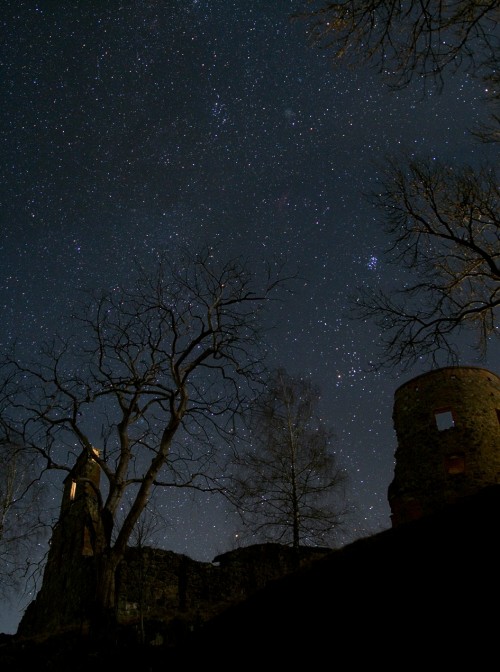
Starry Night Castle
Credit & Copyright: P-M Hedén
Explanation: The tantalizing Pleiades star cluster seems to lie just beyond the trees above a dark castle tower in this dramatic view of The World at Night. Recorded earlier this month, the starry sky also features bright star Aldebaran below the Pleiades and a small, faint, fuzzy cloud otherwise known as Comet Holmes near picture center at the top of the field. Starry Night Castle might be an appropriate name for the medieval castle ruin in the foreground. But its traditional name is Mörby Castle, found north of Stockholm, near lake Skedviken in Norrtälje, Sweden.

Starry Night Castle
Credit & Copyright: P-M Hedén
Explanation: The tantalizing Pleiades star cluster seems to lie just beyond the trees above a dark castle tower in this dramatic view of The World at Night. Recorded earlier this month, the starry sky also features bright star Aldebaran below the Pleiades and a small, faint, fuzzy cloud otherwise known as Comet Holmes near picture center at the top of the field. Starry Night Castle might be an appropriate name for the medieval castle ruin in the foreground. But its traditional name is Mörby Castle, found north of Stockholm, near lake Skedviken in Norrtälje, Sweden.
2008 January 20
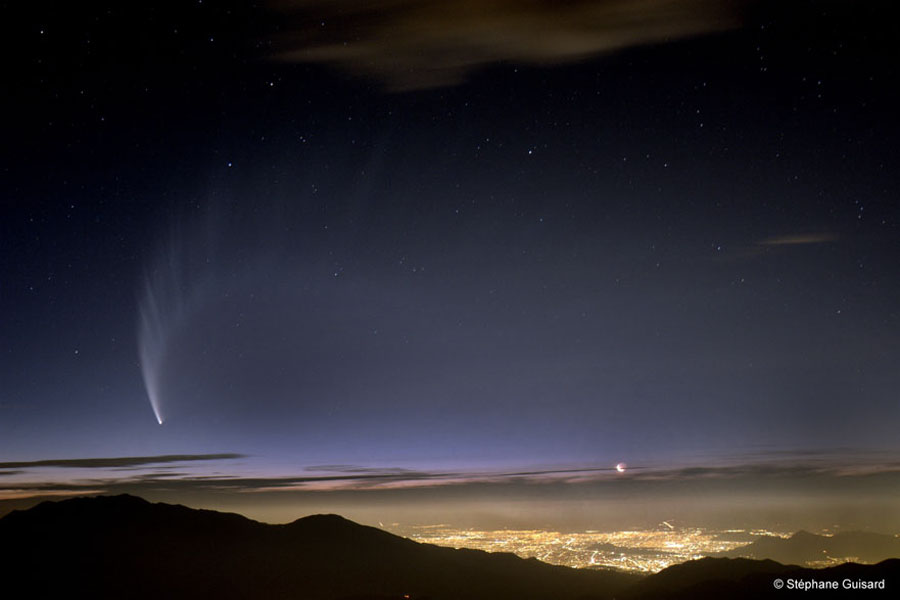
Comet McNaught Over Chile
Credit & Copyright: Stéphane Guisard
Explanation: Comet McNaught was perhaps the most photogenic comet of our time. After making quite a show in the northern hemisphere in early January, the comet moved south and developed a long and unusual dust tail that dazzled southern hemisphere observers. In this image, Comet McNaught was captured one year ago above Chile. The bright comet dominates on the left while part of its magnificent tail spreads across the entire picture. From this vantage point in the Andes Mountains, one looks up toward Comet McNaught and a magnificent sky, across at a crescent moon, and down on clouds, atmospheric haze, and the city lights of Santiago. Comet McNaught has glided into the outer Solar System and is now only visible as a speck in a large telescope. The other spectacular comet of 2007, Comet Holmes, has also faded from easy view.

Comet McNaught Over Chile
Credit & Copyright: Stéphane Guisard
Explanation: Comet McNaught was perhaps the most photogenic comet of our time. After making quite a show in the northern hemisphere in early January, the comet moved south and developed a long and unusual dust tail that dazzled southern hemisphere observers. In this image, Comet McNaught was captured one year ago above Chile. The bright comet dominates on the left while part of its magnificent tail spreads across the entire picture. From this vantage point in the Andes Mountains, one looks up toward Comet McNaught and a magnificent sky, across at a crescent moon, and down on clouds, atmospheric haze, and the city lights of Santiago. Comet McNaught has glided into the outer Solar System and is now only visible as a speck in a large telescope. The other spectacular comet of 2007, Comet Holmes, has also faded from easy view.
2008 年 01 月 21 日

MESSENGER拍摄到的水星地平线
影像提供:MESSENGER Teams, JHU APL, NASA
说明:飞越水星上空那将会是什么样子?就是这样的一次冒险旅行,上周MESSENGER飞船就经历了,它首次飞越了距离太阳最近,类似一颗奇怪月球一样的行星。上面的影像是MESSENGER飞船在上方靠近时拍摄到的部分水星表面,拍摄的距离大约为1.5个地球直径那么远。可以看到这颗炽热而荒凉的星球上有许多陨石坑,许多看上去比相同大小的月球环形山浅。水星相对较高的重力作用让较高的结构如陨石坑壁变得更加平坦。MESSENGER飞船拍摄了1000多张水星形象,都将传回地球让行星地质学家进行研究。MESSENGER飞船预计还将对水星进行2次以上的飞越,直到2011年最终进入水星同步轨道位置。

MESSENGER拍摄到的水星地平线
影像提供:MESSENGER Teams, JHU APL, NASA
说明:飞越水星上空那将会是什么样子?就是这样的一次冒险旅行,上周MESSENGER飞船就经历了,它首次飞越了距离太阳最近,类似一颗奇怪月球一样的行星。上面的影像是MESSENGER飞船在上方靠近时拍摄到的部分水星表面,拍摄的距离大约为1.5个地球直径那么远。可以看到这颗炽热而荒凉的星球上有许多陨石坑,许多看上去比相同大小的月球环形山浅。水星相对较高的重力作用让较高的结构如陨石坑壁变得更加平坦。MESSENGER飞船拍摄了1000多张水星形象,都将传回地球让行星地质学家进行研究。MESSENGER飞船预计还将对水星进行2次以上的飞越,直到2011年最终进入水星同步轨道位置。
]]
2008 年 01 月 23 日

宇航员头盔中地球倒影
影像提供:Clayton C. Anderson, Expedition 15 Crew, NASA
说明:这张宇航员的自拍像特别有意思。在上面的影像中,从外向内依次是宇航服反射头盔的边缘,国际空间站的模块,地球,第15远征队宇航员Clay Anderson的手臂以及用来拍摄这张照片的数码相机。这张影像是在去年8月奋进号执行空间站扩建使命期间拍摄。头盔反射看到的巨大的地球弯曲度并不是我们球形地球真正的弯曲度,而恰恰反映的是太空中头盔弯曲度。从距离地球大约400公里远的国际空间站上看,地球的地平线看上去只是微微弯曲而已。预计下月,航天飞机将再一次飞往空间站进行使命活动,其中包括装配哥伦比亚科学实验室。

宇航员头盔中地球倒影
影像提供:Clayton C. Anderson, Expedition 15 Crew, NASA
说明:这张宇航员的自拍像特别有意思。在上面的影像中,从外向内依次是宇航服反射头盔的边缘,国际空间站的模块,地球,第15远征队宇航员Clay Anderson的手臂以及用来拍摄这张照片的数码相机。这张影像是在去年8月奋进号执行空间站扩建使命期间拍摄。头盔反射看到的巨大的地球弯曲度并不是我们球形地球真正的弯曲度,而恰恰反映的是太空中头盔弯曲度。从距离地球大约400公里远的国际空间站上看,地球的地平线看上去只是微微弯曲而已。预计下月,航天飞机将再一次飞往空间站进行使命活动,其中包括装配哥伦比亚科学实验室。
2008 年 01 月 24 日

仙女座宇宙岛
影像提供及版权:Tony Hallas
说明:我们肉眼能轻易看到最遥远的天体就是M31,也就是巨大的仙女座星系,距离我们大约250万光年远。但是,如果没有一架望远镜,即使是如此巨大的旋涡星系(覆盖约20万多光年)看上去也只是一个位于仙女座内昏暗模糊的星云。与之相反,在这张壮观的望远镜数码影像中有明亮的黄色星系核,黑暗的缠绕尘埃带,绚丽的蓝色旋臂和星系团。现在连刚刚入门的观测者也知道宇宙中有许多类似M31的遥远星系,但是在短短的80年内,天文学家们之间连基础的概念都有很严重的争论。这些“旋涡星系”仅仅是我们银河系简单的外围成员,抑或它们是“宇宙岛”—与银河系相当的遥远恒星系统?而这就是1920年著名的Shapley-Curtis之间争论的话题要点,而后通过对M31的观测发现仙女座星云是一个宇宙岛。

仙女座宇宙岛
影像提供及版权:Tony Hallas
说明:我们肉眼能轻易看到最遥远的天体就是M31,也就是巨大的仙女座星系,距离我们大约250万光年远。但是,如果没有一架望远镜,即使是如此巨大的旋涡星系(覆盖约20万多光年)看上去也只是一个位于仙女座内昏暗模糊的星云。与之相反,在这张壮观的望远镜数码影像中有明亮的黄色星系核,黑暗的缠绕尘埃带,绚丽的蓝色旋臂和星系团。现在连刚刚入门的观测者也知道宇宙中有许多类似M31的遥远星系,但是在短短的80年内,天文学家们之间连基础的概念都有很严重的争论。这些“旋涡星系”仅仅是我们银河系简单的外围成员,抑或它们是“宇宙岛”—与银河系相当的遥远恒星系统?而这就是1920年著名的Shapley-Curtis之间争论的话题要点,而后通过对M31的观测发现仙女座星云是一个宇宙岛。
2008 年 01 月 25 日

南方山峰上的冬季夜空
影像提供及版权:Alain Sallez (picdumidi.org), David Romeuf (Université Lyon 1)
说明:这张梦幻般的影像是在著名的南方山峰天文台向南拍摄得到,其中有月光照亮了的圆顶,冬季夜空,以及法国比利牛斯山脉雪峰。在漆黑的夜晚中,La Mongie 滑雪场发出的光照亮附近的山坡,远处地平线的光芒来自法国南部和西班牙城市。夜空中显示了猎户座和双子座的星空特征,影像上边缘中央左侧位置是明亮的火星。影像中可以看到三个主要的圆顶(从左到右)分别装有专为业余天文爱好者配备的直径为0.6米的望远镜,一架曾被用来服务阿波罗月球登陆使命,直径为1米的望远镜,还有就是新建的太阳观测望远镜CLIMSO。

南方山峰上的冬季夜空
影像提供及版权:Alain Sallez (picdumidi.org), David Romeuf (Université Lyon 1)
说明:这张梦幻般的影像是在著名的南方山峰天文台向南拍摄得到,其中有月光照亮了的圆顶,冬季夜空,以及法国比利牛斯山脉雪峰。在漆黑的夜晚中,La Mongie 滑雪场发出的光照亮附近的山坡,远处地平线的光芒来自法国南部和西班牙城市。夜空中显示了猎户座和双子座的星空特征,影像上边缘中央左侧位置是明亮的火星。影像中可以看到三个主要的圆顶(从左到右)分别装有专为业余天文爱好者配备的直径为0.6米的望远镜,一架曾被用来服务阿波罗月球登陆使命,直径为1米的望远镜,还有就是新建的太阳观测望远镜CLIMSO。
2008 January 26
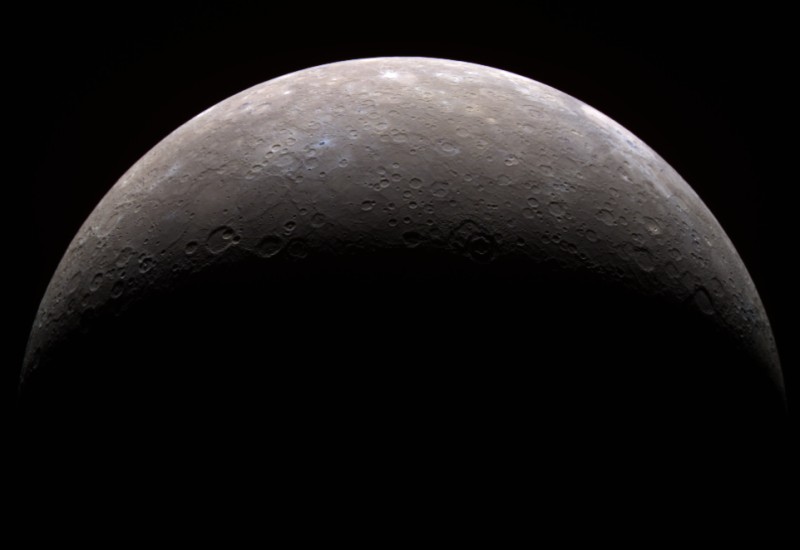
Crescent Mercury in Color
Credit: MESSENGER, NASA, JHU APL, CIW
Explanation: Hard to spot against the twilight glow near planet Earth's horizon, a crescent Mercury was imaged close up by the MESSENGER spacecraft early last week. Colors in this remarkable picture were created using data recorded through infrared, red, and violet filters. The combination enhances color differences otherwise not visible to the eye across the innermost planet's cratered surface. In this view, light bluish material seems to surround relatively new craters, contrasting with the mostly drab, brown terrain. Mercury itself is 4,880 kilometers in diameter. The full resolution image shows features as small as 10 kilometers across.

Crescent Mercury in Color
Credit: MESSENGER, NASA, JHU APL, CIW
Explanation: Hard to spot against the twilight glow near planet Earth's horizon, a crescent Mercury was imaged close up by the MESSENGER spacecraft early last week. Colors in this remarkable picture were created using data recorded through infrared, red, and violet filters. The combination enhances color differences otherwise not visible to the eye across the innermost planet's cratered surface. In this view, light bluish material seems to surround relatively new craters, contrasting with the mostly drab, brown terrain. Mercury itself is 4,880 kilometers in diameter. The full resolution image shows features as small as 10 kilometers across.
2008 January 27

Mercury on the Horizon
Credit & Copyright: Juan Carlos Casado
Explanation: Have you ever seen the planet Mercury? Because Mercury orbits so close to the Sun, it never wanders far from the Sun in Earth's sky. If trailing the Sun, Mercury will be visible low on the horizon for only a short while after sunset. If leading the Sun, Mercury will be visible only shortly before sunrise. So at certain times of the year an informed skygazer with a little determination can usually pick Mercury out from a site with an unobscured horizon. Above, a lot of determination has been combined with a little digital trickery to show Mercury's successive positions during March of 2000. Each picture was taken from the same location in Spain when the Sun itself was 10 degrees below the horizon and superposed on the single most photogenic sunset. Mercury is currently visible in the western sky after sunset, but will disappear in the Sun's glare after a few days.

Mercury on the Horizon
Credit & Copyright: Juan Carlos Casado
Explanation: Have you ever seen the planet Mercury? Because Mercury orbits so close to the Sun, it never wanders far from the Sun in Earth's sky. If trailing the Sun, Mercury will be visible low on the horizon for only a short while after sunset. If leading the Sun, Mercury will be visible only shortly before sunrise. So at certain times of the year an informed skygazer with a little determination can usually pick Mercury out from a site with an unobscured horizon. Above, a lot of determination has been combined with a little digital trickery to show Mercury's successive positions during March of 2000. Each picture was taken from the same location in Spain when the Sun itself was 10 degrees below the horizon and superposed on the single most photogenic sunset. Mercury is currently visible in the western sky after sunset, but will disappear in the Sun's glare after a few days.
2008 年 01 月 28 日

18世纪的日食油画
油画版权:Cosmas Damian Asam;数码影像版权:Jay Pasachoff
说明:这张画是最早表现日全食写实作品吗?一些历史学家们相信这点。上面这张画是科斯玛斯.达米安.阿萨姆在1735年完成的作品,他是一位画家也是18世纪早期德国著名的建筑师。很明显画中并不仅仅是日全食,其中还能看到日冕以及当日光刚从月球山峰之间露出时出现的钻石环效应。影像中描述日食的人叫St. Benedict。Roberta J. M. Olson和Jay Pasachoff认为阿萨姆本人可能亲自看到一次或者所有1706年、1724年和1733年发生的日全食。仅仅通过上一个千年,我们已经了解,或是精确地记录许多宇宙间发生的事实。阿萨姆的画现在就挂在德国巴伐利亚州威尔腾堡修道院内。

18世纪的日食油画
油画版权:Cosmas Damian Asam;数码影像版权:Jay Pasachoff
说明:这张画是最早表现日全食写实作品吗?一些历史学家们相信这点。上面这张画是科斯玛斯.达米安.阿萨姆在1735年完成的作品,他是一位画家也是18世纪早期德国著名的建筑师。很明显画中并不仅仅是日全食,其中还能看到日冕以及当日光刚从月球山峰之间露出时出现的钻石环效应。影像中描述日食的人叫St. Benedict。Roberta J. M. Olson和Jay Pasachoff认为阿萨姆本人可能亲自看到一次或者所有1706年、1724年和1733年发生的日全食。仅仅通过上一个千年,我们已经了解,或是精确地记录许多宇宙间发生的事实。阿萨姆的画现在就挂在德国巴伐利亚州威尔腾堡修道院内。
2008 年 01 月 29 日

勇气号火星探测器拍摄到的西谷全景影像
影像提供:Mars Exploration Rover Mission, Cornell, JPL, NASA
说明:从这里看火星会是什么样子?去年9月,在穿过了高低不平而又光滑的岩层,到达过冬地点前,勇气号探测器爬到了一个名为本垒的小高地上,并且拍摄了上面这张壮观的影像。在这张全景影像的前景中,可以看到颜色较浅的地方就是部分奇怪而顶部平坦的本垒。影像左侧,可以看到8公里远处的Grissom 山丘,而在左侧前景中的是散乱的Tsiolkocski山脊岩石。右侧大约800米远的是Husband山,早已被勇气号探索过,并且是影像向西望去的制高点。而左侧这张插图是一个被戏称为小野人的小突起特写,由于这块静止不动的岩石外表与人的形象相似,从而吸引了很多目光。若果你够坚持的话就能在这张高清晰全景影像中的左前方找到这个小野人岩石。去年12月,勇气号成功地到达了节能较好的过冬地点。

勇气号火星探测器拍摄到的西谷全景影像
影像提供:Mars Exploration Rover Mission, Cornell, JPL, NASA
说明:从这里看火星会是什么样子?去年9月,在穿过了高低不平而又光滑的岩层,到达过冬地点前,勇气号探测器爬到了一个名为本垒的小高地上,并且拍摄了上面这张壮观的影像。在这张全景影像的前景中,可以看到颜色较浅的地方就是部分奇怪而顶部平坦的本垒。影像左侧,可以看到8公里远处的Grissom 山丘,而在左侧前景中的是散乱的Tsiolkocski山脊岩石。右侧大约800米远的是Husband山,早已被勇气号探索过,并且是影像向西望去的制高点。而左侧这张插图是一个被戏称为小野人的小突起特写,由于这块静止不动的岩石外表与人的形象相似,从而吸引了很多目光。若果你够坚持的话就能在这张高清晰全景影像中的左前方找到这个小野人岩石。去年12月,勇气号成功地到达了节能较好的过冬地点。
2008 年 01 月 30 日

小行星2007TU24通过地球
影像提供:Green Bank Radio Telescope, Arecibo Radio Telescope
说明:昨天小行星2007TU24通过地球,没有对地球产生任何危险。这颗宇宙岩石直径估计约250米,刚好在月球轨道外侧滑过。此次小行星通过地球没有什么不寻常,每天都会有小岩石撞击地球,2003年一颗大小像巴士一样的岩石进入了月球轨道,在通过地球之后才被发现。之所以TU24被发现,是因为它太大了。如果TU24撞击地面,那将会形成一次7级地震,并且留下一个城市大小的陨石坑。如果TU24掉进海洋,将会形成一次巨大的海啸,那将造成更大的威胁。这张雷达影像是两天前拍摄的。位于波多黎各的阿雷西博射电望远镜放射出的雷达信号经小行星反射后,被西弗吉尼亚州Green Bank的伯德射电望远镜接收到。合成的影像显示TU24是一个不规则长方形状。TU24只是在3个月前发现的,这就暗示了其它对地球有潜在危险的小行星可能存在于我们太阳系内,只是没被发现。像类似TU24一样的天体很难检测到,因为它们异常昏暗而且运行很快。人类正在搜寻天空,检测,归类,分析这样的天体,在最近几年其数量有显著增加。

小行星2007TU24通过地球
影像提供:Green Bank Radio Telescope, Arecibo Radio Telescope
说明:昨天小行星2007TU24通过地球,没有对地球产生任何危险。这颗宇宙岩石直径估计约250米,刚好在月球轨道外侧滑过。此次小行星通过地球没有什么不寻常,每天都会有小岩石撞击地球,2003年一颗大小像巴士一样的岩石进入了月球轨道,在通过地球之后才被发现。之所以TU24被发现,是因为它太大了。如果TU24撞击地面,那将会形成一次7级地震,并且留下一个城市大小的陨石坑。如果TU24掉进海洋,将会形成一次巨大的海啸,那将造成更大的威胁。这张雷达影像是两天前拍摄的。位于波多黎各的阿雷西博射电望远镜放射出的雷达信号经小行星反射后,被西弗吉尼亚州Green Bank的伯德射电望远镜接收到。合成的影像显示TU24是一个不规则长方形状。TU24只是在3个月前发现的,这就暗示了其它对地球有潜在危险的小行星可能存在于我们太阳系内,只是没被发现。像类似TU24一样的天体很难检测到,因为它们异常昏暗而且运行很快。人类正在搜寻天空,检测,归类,分析这样的天体,在最近几年其数量有显著增加。
2008 年 01 月 31 日

年轻星团Westerlund 2
影像提供:X-射线;Y.Nazé, G.Rauw, J.Manfroid (Université de Liège), CXC, NASA
红外线;E.Churchwell (University of Wisconsin), JPL, Caltech, NASA
说明:在这张用不可见光波段拍摄的显著合成影像中,模糊恒星孕育场RCW49包围着年轻星团Westerlund 2。斯皮策太空望远镜拍摄的红外数据在上面影像中显示黑白色,而钱德拉X射线影像数据(假色)显示了星团中央区域的高能炽热恒星。往巨大的南方星座半人马座看去,上面影像显示的恒星和结构在光学望远镜下都被模糊的尘埃遮蔽了。Westerlund 2本身年龄仅仅只有200万年或者更小,其中包含有我们银河系内一些最亮,大质量恒星,因此也是寿命较短的恒星。在致密的恒星形成区域,已经测定了原行星盘面的红外信号。估计星团距离我们大约2万光年远,而钱德拉拍摄的正方形区域大约有50光年。

年轻星团Westerlund 2
影像提供:X-射线;Y.Nazé, G.Rauw, J.Manfroid (Université de Liège), CXC, NASA
红外线;E.Churchwell (University of Wisconsin), JPL, Caltech, NASA
说明:在这张用不可见光波段拍摄的显著合成影像中,模糊恒星孕育场RCW49包围着年轻星团Westerlund 2。斯皮策太空望远镜拍摄的红外数据在上面影像中显示黑白色,而钱德拉X射线影像数据(假色)显示了星团中央区域的高能炽热恒星。往巨大的南方星座半人马座看去,上面影像显示的恒星和结构在光学望远镜下都被模糊的尘埃遮蔽了。Westerlund 2本身年龄仅仅只有200万年或者更小,其中包含有我们银河系内一些最亮,大质量恒星,因此也是寿命较短的恒星。在致密的恒星形成区域,已经测定了原行星盘面的红外信号。估计星团距离我们大约2万光年远,而钱德拉拍摄的正方形区域大约有50光年。
2008 年 02 月 01 日

首颗探测器
影像提供:Courtesy of Marshall Space Flight Center, NASA
说明:在50年前(1958年1月31日),第一颗探测器就由陆军弹道飞弹署发射升空进入地球同步轨道。开辟美国太空探索的新纪元的探测器Ⅰ是一枚重30磅的卫星,它携带了测量温度和微陨星碰撞的仪器,还有一个由James A. Van Allen设计的实验用来测定空间中电子和离子的密度。Van Allen的实验测得的结果找到了意想不到、令人吃惊的发现—在地球磁气圈外截流了一条环绕地球的高能电子和离子环,现在被称为Van Allen辐射带。探测器Ⅰ在1958年2月28日停止了数据传送,但直到1970年3月仍留在轨道上空。太空探索先驱James Van Allen在2006年8月9日逝世,享年91岁。

首颗探测器
影像提供:Courtesy of Marshall Space Flight Center, NASA
说明:在50年前(1958年1月31日),第一颗探测器就由陆军弹道飞弹署发射升空进入地球同步轨道。开辟美国太空探索的新纪元的探测器Ⅰ是一枚重30磅的卫星,它携带了测量温度和微陨星碰撞的仪器,还有一个由James A. Van Allen设计的实验用来测定空间中电子和离子的密度。Van Allen的实验测得的结果找到了意想不到、令人吃惊的发现—在地球磁气圈外截流了一条环绕地球的高能电子和离子环,现在被称为Van Allen辐射带。探测器Ⅰ在1958年2月28日停止了数据传送,但直到1970年3月仍留在轨道上空。太空探索先驱James Van Allen在2006年8月9日逝世,享年91岁。
2008 年 02 月 02 日

黎明星空中的金星和木星
影像提供及版权:Babak Tafreshi (TWAN)
说明:在日出前天空中明亮闪烁的这两颗天体,它们实际上是太阳的子女-金星和木星。夜空中金星与木星是亮度仅次于月球之后第二亮和第三亮的天体,在这张影像拍摄于1月30日,金星和木星相距只有2度,但昨天凌晨,两颗天体相距仅仅半度。影像前景中的是Miankaleh 半岛和戈尔干湾的海岸线,这是里海东南部重要的鸟类和野生动植物栖息地。在今后几天里,地球上早期的人们将能欣赏到紧密相伴的金星和木星以及一轮残月。

黎明星空中的金星和木星
影像提供及版权:Babak Tafreshi (TWAN)
说明:在日出前天空中明亮闪烁的这两颗天体,它们实际上是太阳的子女-金星和木星。夜空中金星与木星是亮度仅次于月球之后第二亮和第三亮的天体,在这张影像拍摄于1月30日,金星和木星相距只有2度,但昨天凌晨,两颗天体相距仅仅半度。影像前景中的是Miankaleh 半岛和戈尔干湾的海岸线,这是里海东南部重要的鸟类和野生动植物栖息地。在今后几天里,地球上早期的人们将能欣赏到紧密相伴的金星和木星以及一轮残月。
2008 年 02 月 03 日

麒麟座V838星的回光
影像提供:NASA and the Hubble Heritage Team (AURA/STScI)
说明:是什么造成了麒麟座V838星的这次爆发?因某些未知的原因,麒麟座V838星的外表面突然急剧地扩张,让它成为2002年1月整个银河系内最亮的天体。尔后突然之间它黯淡下来。像类似的恒星闪亮以前从来没有发生过—超新星和新星向空间喷射出物质。尽管麒麟座V838星闪烁看上去也是向空间喷射物质,在上面哈勃太空望远镜拍摄的影像中可以看到,实际上是外表层有一层向外移动的明亮回光。这颗恒星的周围,原来就包着数层结构很复杂的星际尘埃,而回光则是外围气壳反射闪光的现象。麒麟座V838距离我们大约2万光年远,位于麒麟座内,上面影像中的回光直径大约6光年。

麒麟座V838星的回光
影像提供:NASA and the Hubble Heritage Team (AURA/STScI)
说明:是什么造成了麒麟座V838星的这次爆发?因某些未知的原因,麒麟座V838星的外表面突然急剧地扩张,让它成为2002年1月整个银河系内最亮的天体。尔后突然之间它黯淡下来。像类似的恒星闪亮以前从来没有发生过—超新星和新星向空间喷射出物质。尽管麒麟座V838星闪烁看上去也是向空间喷射物质,在上面哈勃太空望远镜拍摄的影像中可以看到,实际上是外表层有一层向外移动的明亮回光。这颗恒星的周围,原来就包着数层结构很复杂的星际尘埃,而回光则是外围气壳反射闪光的现象。麒麟座V838距离我们大约2万光年远,位于麒麟座内,上面影像中的回光直径大约6光年。
2008 年 02 月 04 日

水星上蜘蛛状陨石坑
影像提供:MESSENGER, NASA, JHU APL, CIW
说明:为什么水星上的这个陨石坑看起来像只蜘蛛? 当上个月MESSENGER飞船掠过水星时,拍摄到了这颗离太阳最近行星的影像,而那些都是从未看过的。当拍摄水星中央巨大的卡洛斯盆地时,MESSENGER发现了一个陨石坑,如上图所示,可以看到从它的中心放射出一组奇怪的射线。具有如此低谷的陨石坑在我们太阳系内还从未发现过。陨石坑与辐射状盆地有没有联系现在还不清楚。可能是陨石坑形成了放射状的线条,或者可能是两种特征看上去只是偶然重叠而以—可以确定它将成为未来的研究课题。2011年在MESSENGER飞船点燃推进器进入水星轨道之前,预计它还将飞越水星两次以上。

水星上蜘蛛状陨石坑
影像提供:MESSENGER, NASA, JHU APL, CIW
说明:为什么水星上的这个陨石坑看起来像只蜘蛛? 当上个月MESSENGER飞船掠过水星时,拍摄到了这颗离太阳最近行星的影像,而那些都是从未看过的。当拍摄水星中央巨大的卡洛斯盆地时,MESSENGER发现了一个陨石坑,如上图所示,可以看到从它的中心放射出一组奇怪的射线。具有如此低谷的陨石坑在我们太阳系内还从未发现过。陨石坑与辐射状盆地有没有联系现在还不清楚。可能是陨石坑形成了放射状的线条,或者可能是两种特征看上去只是偶然重叠而以—可以确定它将成为未来的研究课题。2011年在MESSENGER飞船点燃推进器进入水星轨道之前,预计它还将飞越水星两次以上。
2008 February 5

Three Month Composite of Comet Holmes
Credit & Copyright: John Pane
Explanation: How has Comet Holmes changed? Since brightening unexpectedly by nearly one million fold in late October, the last three months have found the coma of Comet 17P/Holmes both expanding and fading. This spectacular composite image shows how the coma and tail of Comet Holmes have changed. Due to Earth's changing vantage point, Comet Holmes, out beyond the orbit of Mars, was seen in November nearly head-on, but in recent months is seen more from the side. Additionally, the comet's motion, when combined with Earth's changing perspective, has caused the comet to have shifted relative to the background stars. The curved path of Comet Holmes shows it to be undergoing apparent retrograde motion as the Earth orbits quickly in front of it. The extent of the coma currently makes Comet Holmes over five times the physical size of our Sun. Anecdotal evidence holds that the comet is hard to see without long photographic exposures, but on such exposures the comet may still be an impressive sight.

Three Month Composite of Comet Holmes
Credit & Copyright: John Pane
Explanation: How has Comet Holmes changed? Since brightening unexpectedly by nearly one million fold in late October, the last three months have found the coma of Comet 17P/Holmes both expanding and fading. This spectacular composite image shows how the coma and tail of Comet Holmes have changed. Due to Earth's changing vantage point, Comet Holmes, out beyond the orbit of Mars, was seen in November nearly head-on, but in recent months is seen more from the side. Additionally, the comet's motion, when combined with Earth's changing perspective, has caused the comet to have shifted relative to the background stars. The curved path of Comet Holmes shows it to be undergoing apparent retrograde motion as the Earth orbits quickly in front of it. The extent of the coma currently makes Comet Holmes over five times the physical size of our Sun. Anecdotal evidence holds that the comet is hard to see without long photographic exposures, but on such exposures the comet may still be an impressive sight.
2008 February 6

A Sunspot in the New Solar Cycle
Credit & Copyright: Greg Piepol
Explanation: A new cycle has begun on our Sun. Over the past year, the Sun's magnetic field has reset and now a new 11 year period is beginning. Pictured above in a specific color of light emitted by hydrogen is sunspot 10982, one of the first sunspots of the new solar cycle. The two dark lines visible just above and to either side of the bright sunspot are cool filaments held aloft by the Sun's magnetic field. Hot and cold regions are shown as regions of relative light and dark, respectively. A solar cycle is caused by the changing magnetic field, and varies from solar maximum, when sunspot, coronal mass ejection, and flare phenomena are most frequent, to solar minimum, when such activity is relatively infrequent. Solar minimums occurred in 1996 and 2007, while the last solar maximum occurred in 2001. Of course, tomorrow's annular solar eclipse is mostly for penguins.

A Sunspot in the New Solar Cycle
Credit & Copyright: Greg Piepol
Explanation: A new cycle has begun on our Sun. Over the past year, the Sun's magnetic field has reset and now a new 11 year period is beginning. Pictured above in a specific color of light emitted by hydrogen is sunspot 10982, one of the first sunspots of the new solar cycle. The two dark lines visible just above and to either side of the bright sunspot are cool filaments held aloft by the Sun's magnetic field. Hot and cold regions are shown as regions of relative light and dark, respectively. A solar cycle is caused by the changing magnetic field, and varies from solar maximum, when sunspot, coronal mass ejection, and flare phenomena are most frequent, to solar minimum, when such activity is relatively infrequent. Solar minimums occurred in 1996 and 2007, while the last solar maximum occurred in 2001. Of course, tomorrow's annular solar eclipse is mostly for penguins.
2008 February 7
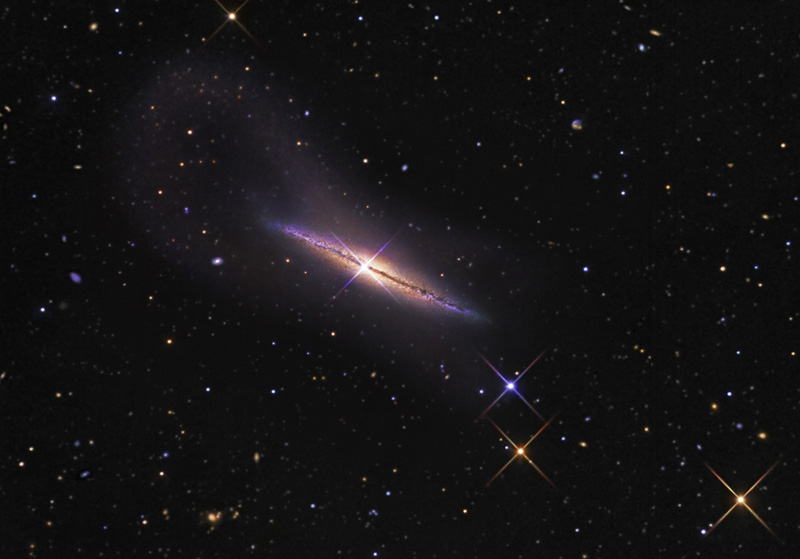
NGC 4013 and the Tidal Stream
Image Credit & Copyright: R Jay Gabany (Blackbird Observatory) - collaboration; D.Martínez-Delgado(IAC, MPIA),
M.Pohlen (Cardiff), S.Majewski (U.Virginia), J.Peñarrubia (U.Victoria), C.Palma (Penn State)
Explanation: Nearly 50 million light-years away in the constellation Ursa Major, NGC 4013 was long considered an isolated island universe. Seen edge-on, the gorgeous spiral galaxy was known for its flattened disk and central bulge of stars, cut by silhouetted dust lanes. But this deep color image of the region reveals a previously unknown feature associated with NGC 4013, an enormous, faint looping structure extending (above and toward the left) over 80 thousand light-years from the galaxy's center. A detailed exploration of the remarkable structure reveals it to be a stream of stars originally belonging to another galaxy, likely a smaller galaxy torn apart by gravitational tides as it merged with the larger spiral. Astronomers argue that the newly discovered tidal stream also explains a warped distribution of neutral hydrogen gas seen in radio images of NGC 4013 and offers parallels to the formation of our own Milky Way galaxy.

NGC 4013 and the Tidal Stream
Image Credit & Copyright: R Jay Gabany (Blackbird Observatory) - collaboration; D.Martínez-Delgado(IAC, MPIA),
M.Pohlen (Cardiff), S.Majewski (U.Virginia), J.Peñarrubia (U.Victoria), C.Palma (Penn State)
Explanation: Nearly 50 million light-years away in the constellation Ursa Major, NGC 4013 was long considered an isolated island universe. Seen edge-on, the gorgeous spiral galaxy was known for its flattened disk and central bulge of stars, cut by silhouetted dust lanes. But this deep color image of the region reveals a previously unknown feature associated with NGC 4013, an enormous, faint looping structure extending (above and toward the left) over 80 thousand light-years from the galaxy's center. A detailed exploration of the remarkable structure reveals it to be a stream of stars originally belonging to another galaxy, likely a smaller galaxy torn apart by gravitational tides as it merged with the larger spiral. Astronomers argue that the newly discovered tidal stream also explains a warped distribution of neutral hydrogen gas seen in radio images of NGC 4013 and offers parallels to the formation of our own Milky Way galaxy.
2008 February 8
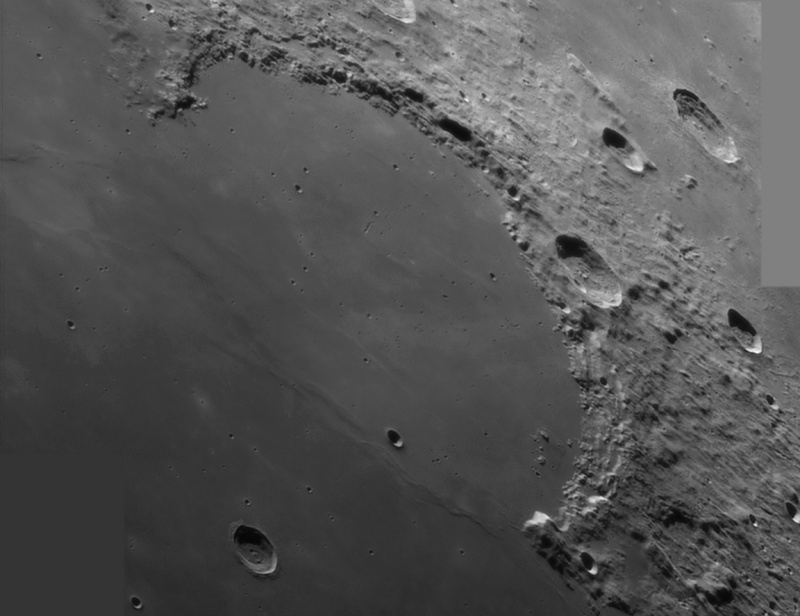
The Bay of Rainbows
Credit & Copyright: Alan Friedman
Explanation: Dark, smooth regions that cover the Moon's familiar face are called by Latin names for oceans and seas. The naming convention is historical, though it may seem a little ironic to denizens of the space age who recognize the Moon as a mostly dry and airless world, and the smooth, dark areas as lava-flooded impact basins. For example, this elegant lunar vista, a careful mosaic of telescopic images, looks across the expanse of the northwestern Mare Imbrium, or Sea of Rains, into the Sinus Iridum - the Bay of Rainbows. Ringed by the Jura Mountains (montes), the bay is about 250 kilometers across, bounded at the bottom of the rugged arc by Cape (promontorium) Laplace. The cape's sunlit face towers nearly 3,000 meters above the bay's surface. At the top of the arc is Cape Heraclides, at times seen as a moon maiden.

The Bay of Rainbows
Credit & Copyright: Alan Friedman
Explanation: Dark, smooth regions that cover the Moon's familiar face are called by Latin names for oceans and seas. The naming convention is historical, though it may seem a little ironic to denizens of the space age who recognize the Moon as a mostly dry and airless world, and the smooth, dark areas as lava-flooded impact basins. For example, this elegant lunar vista, a careful mosaic of telescopic images, looks across the expanse of the northwestern Mare Imbrium, or Sea of Rains, into the Sinus Iridum - the Bay of Rainbows. Ringed by the Jura Mountains (montes), the bay is about 250 kilometers across, bounded at the bottom of the rugged arc by Cape (promontorium) Laplace. The cape's sunlit face towers nearly 3,000 meters above the bay's surface. At the top of the arc is Cape Heraclides, at times seen as a moon maiden.